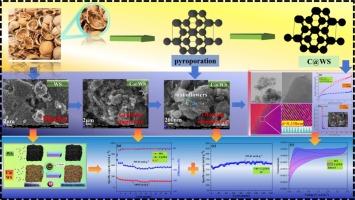核桃壳碳包覆三维多孔碳纳米花的合成及电化学性能研究
IF 5.1
3区 材料科学
Q2 MATERIALS SCIENCE, COATINGS & FILMS
引用次数: 0
摘要
在本研究中,利用熔盐作为反应介质,促进成孔剂的活化,成功合成了一种新型锂离子电池材料——碳包覆的三维多孔碳纳米花(C@WS)。所得C@WS保留了原始核桃壳(WS)固有的无序碳蜂窝结构,并具有增强的比表面积(WS为930.9 m2 - 1, C@WS为1227.1 m2 - 1)。此外,在碳涂层和WS基材之间形成了独特的CC核/壳结构。电化学分析表明C@WS具有优异的锂存储能力,在0.1C (40.7 mA g−1)电流密度下,其比容量为569.41 mAhg−1。它还表现出优异的倍率性能,在0.5℃下保持381.45 mAhg−1的容量,具有优异的循环稳定性和显著的容量恢复,在3C下循环900次后仍保持99.3%的初始容量。此外,碳涂层显著提高了初始库仑效率(11.93%)和锂离子扩散动力学,扩散系数(DLi+) C@WS (2.52 × 10−7 cm2 s−1)显著高于WS (1.86 × 10−7 cm2 s−1)。本文章由计算机程序翻译,如有差异,请以英文原文为准。

Synthesis and electrochemical performance of carbon-coated three-dimensional porous carbon nanoflowers derived from walnut shells for lithium-ion battery applications
In this study, a novel lithium-ion battery material, carbon-coated three-dimensional porous carbon nanoflowers derived from walnut shells (C@WS), was successfully synthesized by utilizing molten salt as a reaction medium to promote the activation of pore-forming agents. The resulting C@WS retains the disordered carbon honeycomb structure inherent in the original walnut shell (WS), with an enhanced specific surface area (930.9 m2g−1 for WS and 1227.1 m2g−1 for C@WS). Moreover, a unique C![]() C core/shell architecture is formed between the carbon coating and the WS substrate. Electrochemical analysis demonstrates that C@WS exhibits excellent lithium storage capacity, delivering a specific capacity of 569.41 mAhg−1 at a current density of 0.1C (40.7 mA g−1). It also shows superior rate capability, maintaining a capacity of 381.45 mAhg−1 at 0.5C, as well as excellent cycling stability and remarkable capacity recovery, retaining 99.3 % of its initial capacity after 900 cycles at 3C. Furthermore, the carbon coating significantly enhances both the initial Coulombic efficiency (by 11.93 %) and the lithium-ion diffusion kinetics, with the diffusion coefficient (DLi+) of C@WS (2.52 × 10−7 cm2 s−1) being notably higher than that of WS (1.86 × 10−7 cm2 s−1).
C core/shell architecture is formed between the carbon coating and the WS substrate. Electrochemical analysis demonstrates that C@WS exhibits excellent lithium storage capacity, delivering a specific capacity of 569.41 mAhg−1 at a current density of 0.1C (40.7 mA g−1). It also shows superior rate capability, maintaining a capacity of 381.45 mAhg−1 at 0.5C, as well as excellent cycling stability and remarkable capacity recovery, retaining 99.3 % of its initial capacity after 900 cycles at 3C. Furthermore, the carbon coating significantly enhances both the initial Coulombic efficiency (by 11.93 %) and the lithium-ion diffusion kinetics, with the diffusion coefficient (DLi+) of C@WS (2.52 × 10−7 cm2 s−1) being notably higher than that of WS (1.86 × 10−7 cm2 s−1).
求助全文
通过发布文献求助,成功后即可免费获取论文全文。
去求助
来源期刊

Diamond and Related Materials
工程技术-材料科学:综合
CiteScore
6.00
自引率
14.60%
发文量
702
审稿时长
2.1 months
期刊介绍:
DRM is a leading international journal that publishes new fundamental and applied research on all forms of diamond, the integration of diamond with other advanced materials and development of technologies exploiting diamond. The synthesis, characterization and processing of single crystal diamond, polycrystalline films, nanodiamond powders and heterostructures with other advanced materials are encouraged topics for technical and review articles. In addition to diamond, the journal publishes manuscripts on the synthesis, characterization and application of other related materials including diamond-like carbons, carbon nanotubes, graphene, and boron and carbon nitrides. Articles are sought on the chemical functionalization of diamond and related materials as well as their use in electrochemistry, energy storage and conversion, chemical and biological sensing, imaging, thermal management, photonic and quantum applications, electron emission and electronic devices.
The International Conference on Diamond and Carbon Materials has evolved into the largest and most well attended forum in the field of diamond, providing a forum to showcase the latest results in the science and technology of diamond and other carbon materials such as carbon nanotubes, graphene, and diamond-like carbon. Run annually in association with Diamond and Related Materials the conference provides junior and established researchers the opportunity to exchange the latest results ranging from fundamental physical and chemical concepts to applied research focusing on the next generation carbon-based devices.
 求助内容:
求助内容: 应助结果提醒方式:
应助结果提醒方式:


